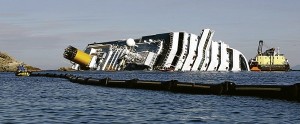Italy court hearings set scene for Concordia shipwreck trial
GROSSETO, Italy—A series of pre-trial hearings into the Costa Concordia shipwreck with captain Francesco Schettino wrapped up on Friday, paving the way for a trial on a tragedy in which 32 people died.
The hearing brought to an end a week of heated debates between lawyers and technical experts on the details of what happened that night of January 13 when the luxury liner smashed into an offshore reef near the shores of Tuscany.
The Tuscan town of Grosseto had been overrun all week with journalists who hounded Schettino, taunting him and snapping paparazzi photographs of the captain with his slicked-back hair, flashy suits and trademark sunglasses.
“Captain Coward”, as he became known after he abandoned the ship before it was evacuated, was clearly frustrated by how the hearings were going and was reportedly told by his lawyer to calm down or he would have to leave the court.
The giant luxury cruise ship — more than twice as big as the Titanic — had 4,229 people on board when it struck an offshore reef near the Italian island of Giglio on the evening of January 13, tearing a massive gash in its hull.
Article continues after this advertisement“These technical hearings have put the nail in the coffin as far as the captain’s responsibilities are concerned,” prosecutor Francesco Verusio said Friday, though Schettino’s lawyer Bruno Leporatti insisted “we’ve come out of this better than we went in.”
Article continues after this advertisementThe vessel quickly took on water, veered sharply and keeled over just a few dozen meters from the shore, sparking a panicky night-time evacuation.
The disaster left 32 people dead and led to accusations of safety breaches, cowardice and fatal delays, many of which have been debated over the past week as technical experts presented findings from the ship’s data and black-box.
A total of 10 people are being investigated including Schettino and six other crew members, as well as three managers from ship owner Costa Crociere, which is part of the world’s biggest cruise operator, US-based Carnival.
The captain has not been charged. He could end up being accused of multiple manslaughter and abandoning the ship before all the passengers were safely ashore.
No date has been set for the trial but it is expected to begin in spring.
The drama of the upcoming trial began to emerge this week, with a clear stand-off between Schettino and Costa Crociere over responsibilities.
While a coast guard report fingered Costa Crociere for not informing them as soon as they had the information about the crash — potentially causing fatal delays — the company said it was the captain’s role to alert rescue services.
It also slammed Schettino for trying to blame his subordinates for things he had full responsibility for. The captain insists the crash happened because the Indonesian helmsman misunderstood his orders and steered the wrong way.
He has also said that fellow officers should have spotted the rocks — a complaint overshadowed by the damning fact that he was talking on the phone when carrying out a risky manoeuver and had unauthorized guests on the bridge.
“The hearings have confirmed that the helmsman’s mistake was such that the ship would have finished on the rocks anyway,” Verusio said.
— ‘Manoeuvre directed by the good God —
Schettino’s defense team have insisted that the captain acted following the crash to ensure the boat did not drift out to sea and sink into the depths.
But his claims were roundly dismissed by the experts, who said that the ship’s engines cut out two minutes after impact and could not be controlled, and it ended up back near the shore because of momentum, wind and current.
“It was not a manoeuver carried out by Schettino, it was a manoeuver directed by the good God,” Verusio said.
Passengers and crew from dozens of countries were on board the Mediterranean cruise, including particularly large contingents of Italian, French and German cruise-goers, as well as staff from India, Indonesia and the Philippines.
Dozens of survivors are suing Costa Crociere and its US parent company Carnival Corporation for hundreds of millions of dollars. Some at the hearings said they were still traumatized and had come to look Schettino in the eye.
Italian consumer group Codacons, which has launched a class action lawsuit, deplored a lack of attention to the victims and the manner in which they died.
Costa Crociere’s legal and risk management director Alessandro Carella paid tribute to the ship’s crew who had helped save thousands of passengers.
“They found themselves having to work in extraordinary conditions, made much more difficult by the great delay in giving the order to evacuate,” he said.
The ghostly wreck of the liner is still beached on its side just a few dozen metrers from the shore of Giglio. Salvage crews are working flat out to stabilize and refloat the hulk by next year in an unprecedented operation.
But the US company Titan tasked with removing the wreck in the biggest ever marine salvage project of its kind said there were major delays.
“The initial timeline is going to be blown out of the water,” Nick Sloane, Titan’s senior salvage master, said at the site of the operation.
On Friday, Giglio mayor Sergio Ortelli called for an explanation for the delays and insisted he wanted to avoid “serious repercussions on the island community” in a letter sent to the head of Italy’s civil protection agency, which is in charge of the operation, and to the Concordia monitoring observatory.
The 290-meter (951-foot) Costa Concordia weighs in at 114,500 gross tonnes, making it the largest passenger shipwreck by tonnage in history.
